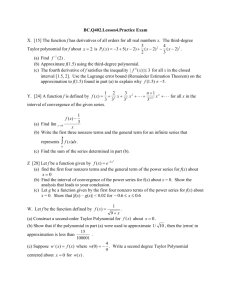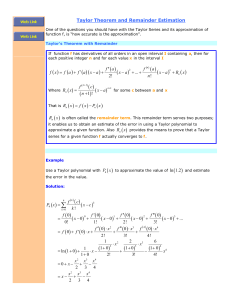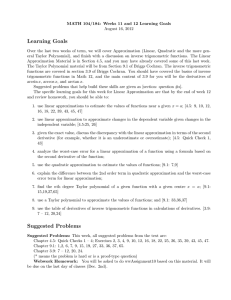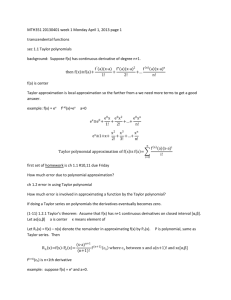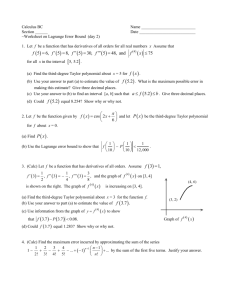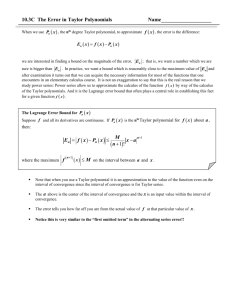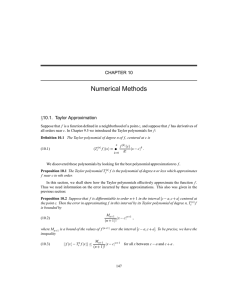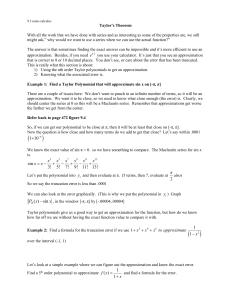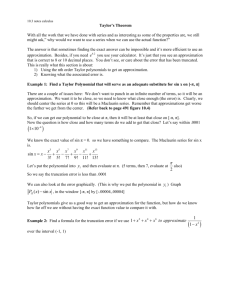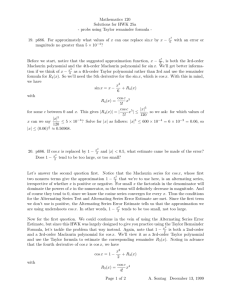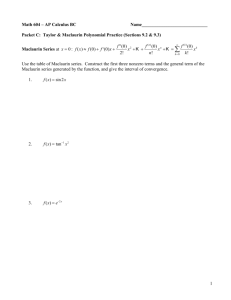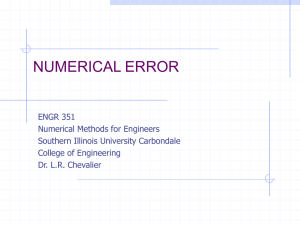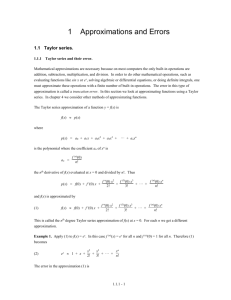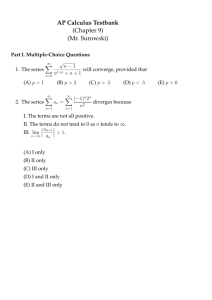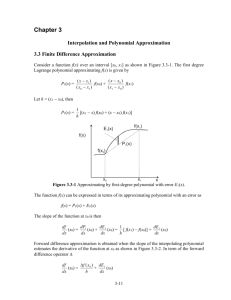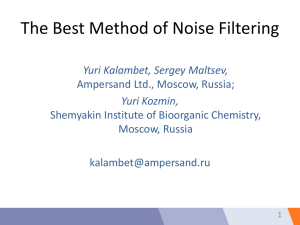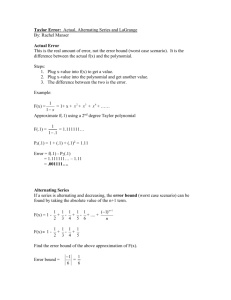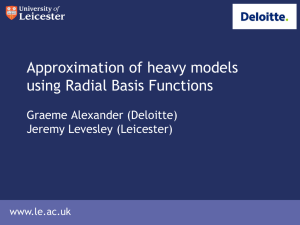Section 11.6 - Taylor`s Formula with Remainder
advertisement
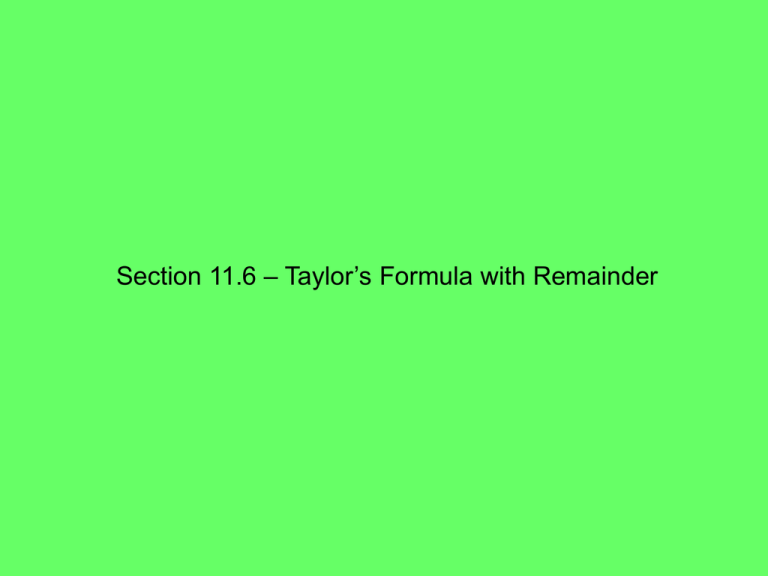
Section 11.6 – Taylor’s Formula with Remainder The Lagrange Remainder of a Taylor Polynomial Rn x z n 1 x n 1 ! f n 1 where z is some number between x and c The Error of a Taylor Polynomial Rn x M n 1 ! bc n 1 where M is the maximum value of f on the interval [b, c] or [c, b] n 1 x Let f be a function that has derivatives of all orders on the Interval (-1, 1). Assume f(0) = 1, f ‘ (0) = ½, f ”(0) = -1/4, f ’’’(0) = 3/8 and f 4 x 6 for all x in the interval (0, 1). a. Find the third-degree Taylor polynomial about x = 0 for f. p3 x 1 p3 x 1 1 2 1 2 x 1/ 4 x 1 2! 8 x 2 x 2 3/8 1 x 3 3! x 3 16 b. Use your answer to part a to estimate the value of f(0.5) p 3 0 .5 1 p 3 0 .5 1 2 157 128 1 0 .5 0 .5 8 1 .2 2 7 2 1 16 0 .5 3 Let f be a function that has derivatives of all orders on the Interval (-1, 1). Assume f(0) = 1, f ‘ (0) = ½, f ”(0) = -1/4, f ’’’(0) = 3/8 and f 4 x 6 for all x in the interval (0, 1). c. What is the maximum possible error for the approximation made in part b? p 3 0 .5 R3 x R3 x R3 x 157 128 1 .2 2 7 M 3 1 ! 4 f x 3 1 ! 6 4 ! bc bc 0 .5 0 4 3 1 3 1 1 64 0 .0 1 6 Estimate the error that results when arctan x is replaced by x x 3 3 if x 0 .2 a n d f 4 x R3 x R3 x R3 x 4 M 3 1 ! 4 3 1 ! 1 6 0 .2 4 bc 3 1 0 .2 0 3 1 0 .0 0 0 2 6 7 Estimate the error that results when ln(x + 1) is replaced by x 1 2 x if x 0 .1 2 f x ln x 1 f 'x f "x f "' x 1 R2 x f ''' 0.1 2 1 ! R 2 x 0.000457 x 1 1 x 1 2 2 x 1 3 F ‘’’ (x) has a maximum value at x = -0.1 0 0.1 2 1 Find an approximation of ln 1.1 that is accurate to three decimal places. We just determined that the error using the second degree expansion is 0.000457. p2 x x 1 x 2 2 p 2 0 .1 0 .1 p 2 0.1 0.095 1 2 0 .1 2 Use a Taylor Polynomial to estimate cos(0.2) to 3 decimal places co s x 1 x 2 2! x 4 4! x 6 6! ... If x = 0.2, Alternating Series Test works for convergence 0.2 2n ! 2n 0.005 cos x 1 0 .2 2! 2 0 .9 8 1 Use a Taylor Polynomial to estimate place accuracy. 1 0 3 5 1 x x ... dx x x 3! 5! sin x 0 dx with three decimal x 1 2n 1 2n 1 ! 0 .0 0 5 2 4 x x 1 3 ! 5 ! ... dx 0 1 3 5 7 1 x x x ... |o x 3 3! 5 5! 7 7! 1 1 1 1 ... 3 3! 5 5! 7 7! Satisfies Alternating Series Test 1 1 3 3! 1 5 5! 0 .9 4 6 Suppose the function f is defined so that f 1 1 2 , f ' 1 1 2 2 3x 1 , f " x x 2 2 1 3 a. Write a second degree Taylor polynomial for f about x = 1 p2 x p2 x 1 2 1 2 1 2 1 2 x 1 1/ 2 x 1 1 2! 4 x 1 x 1 2 2 b. Use the result from (a) to approximate f(1.5) p 2 1 .5 1 2 1 2 1 .5 1 1 4 1 .5 1 2 0 .3 1 2 5 Suppose the function f is defined so that f 1 c. If f " x 1 1 2 , f ' 1 1 2 , f " x 2 3x 1 x R2 x 2 M n 1 ! M 2 1 ! R2 x M 2 1 3 for all x in [1, 1.5], find an upper bound for the approximation error in part b if f "' x Rn x 2 0 .5 bc 24 x 1 x x 2 4 0 .5 3 1 2 n 1 1 .5 1 2 1 3 6 R 2 x 0 .4 2 0 9 6 0 .0 0 8 7 7 The first four derivatives of f x f 'x 1 1 x are 1 2 1 x f "x f "' x f "" x a. Find the third-degree Taylor approximation to f at x = 0 3/2 3 4 1 x 5/2 b. Use your answer in (a) to find an approximation of f(0.5) 15 8 1 x 7/2 105 1 6 1 x 9/2 c. Estimate the error involved in the approximation in (b). Show your reasoning. 1 The first four derivatives of f x f 'x 1 2 1 x f "x f "' x f "" x 1 x a. Find the third-degree Taylor approximation to f at x = 0 3/2 f 0 1 3 4 1 x f ' 0 5/2 p3 x 1 15 8 1 x are 1 2 1 f " 0 2 x 3/4 x 3 2! x 2 3 4 15 / 8 15 f "' 0 x 8 3 3! 7/2 p3 x 1 105 1 6 1 x 9/2 1 2 8 x 2 5 x 3 16 b. Use your answer in (a) to find an approximation of f(0.5) p 3 0 .5 1 p 3 0 .5 1 2 103 128 3 0 .5 0 .5 8 2 5 16 0 .5 3 The first four derivatives of f x f 'x 1 2 1 x f "x f "' x f "" x 1 x 3 5/2 R3 x 15 8 1 x 7/2 105 1 6 1 x are c. Estimate the error involved in the approximation in (b). Show your reasoning. 3/2 4 1 x 1 9/2 M 3 1 ! R3 x 105 / 16 R3 x 105 3 1 ! 384 0 .5 0 .5 0 0 .5 0 4 3 1 3 1 35 2048 0 .0 1 7
